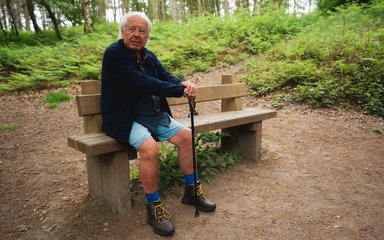Haughmond Hill is a modest hill rising to 502 feet in Shropshire, England, located just east of Shrewsbury. It is predominantly covered by a mix of coniferous and deciduous woodland, although there is a neighbouring open cast quarry (for stone aggregates) in use, visible from a viewing platform.
The hill consists of ancient turbidite sediments from the late Precambrian era, which once cascaded from the edge of a continent into the surrounding ocean.
The main viewpoint is the site of an Iron Age enclosure. During the Battle of Shrewsbury in 1403, Henry IV’s armies gathered on and around the hill after marching from Worcester. Queen Eleanor's Bower, a small enclosure on the hill, is believed to be where the wife of Henry IV observed the battle.

Nancy Spragg’s Cottage
In 1842, Nancy married Thomas Spragg (b.1813), a farm labourer, and moved into Hill Cottage at the top of Haughmond Hill. The cottage lacked electricity, gas, and running water, so Nancy had to collect water from a nearby spring to make tea and lemonade for passing walkers. Although little remains of the original cottage, visitors can still find the spring and the remnants of the plum trees that once grew in her garden.
Trail history
Corbet trail
The trail is named after the Corbet Family, who were the owners of Sundorne Estate from the late 1700s to the 1950s. They once owned Haughmond Hill, the Abbey and much of the surrounding land. Haughmond Castle, a folly which once stood on the viewpoint, was built by John Corbet and stood for 150 years.
Henry’s Hike
Who was Henry? During the battle of Shrewsbury in 1403, Henry IV’s armies amassed here having marched from Worcester. Estimates vary widely, but between 15,000 and 60,000 men made up the royal army of one of the bloodiest battles in Britain.
Wilfred’s Walk
This walk is named in memory of war poet Wilfred Owen who had strong links with the local area and Haughmond Hill in particular.

Present Day
The Forestry Commission became Forestry England in 2019, and today we manage Haughmond Hill. We work to carefully manage the forest for timber, public recreation and wildlife.
Today, Haughmond Hill offers four waymarked walking trails of varying lengths to accommodate all abilities. An easy-access trail is suitable for wheelchairs, mobility scooters, and buggies. For those seeking a challenge, longer trails lead deeper into the forest. A family activity trail is available for younger visitors, with themes that change each year.
No visit is complete without stopping by the Haughmond Hill Cafe, a family-run establishment offering delicious food and drinks.
Visiting Haughmond Hill is free, although parking charges apply. Regular visitors can save money with a Forestry England membership.

